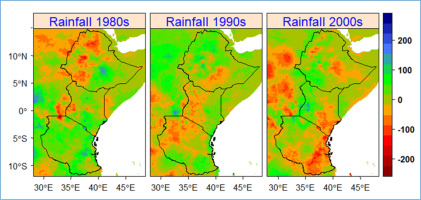当前位置:
X-MOL 学术
›
Glob. Planet. Change
›
论文详情
Our official English website, www.x-mol.net, welcomes your
feedback! (Note: you will need to create a separate account there.)
Analysis of climate variability and droughts in East Africa using high-resolution climate data products
Global and Planetary Change ( IF 4.0 ) Pub Date : 2020-03-01 , DOI: 10.1016/j.gloplacha.2020.103130 Solomon H. Gebrechorkos , Stephan Hülsmann , Christian Bernhofer
Global and Planetary Change ( IF 4.0 ) Pub Date : 2020-03-01 , DOI: 10.1016/j.gloplacha.2020.103130 Solomon H. Gebrechorkos , Stephan Hülsmann , Christian Bernhofer

|
Analysis of climate variability and change as a basis for adaptation and mitigation strategies requires long-term observations. However, the limited availability of ground station data constrains studies focusing on detecting variability and changes in climate and drought monitoring, particularly in developing countries of East Africa. Here, we use high-resolution precipitation (1981–2016) and maximum and minimum temperature (T-max and T-min) (1979–2012) datasets from international databases like the Climate Hazard Group (CHG), representing the most accurate data sources for the region. We assessed seasonal, annual, and decadal variability in rainfall, T-max and T-min and drought conditions using the Standardized Precipitation Index (SPI). The impact of changes in Sea Surface Temperature on rainfall variability and droughts is assessed using the Nino3.4 and Indian Ocean Dipole (IOD) indices. The results show maximum variability in rainfall during October–December (OND, short rainy season) followed by March–May (MAM, long rainy season). Rainfall variability during OND showed a significant correlation with IOD in Ethiopia (69%), Kenya (80%), and Tanzania (63%). In Ethiopia, the period June–September (JJAS) showed a significant negative correlation (−56%) with the Nino3.4. Based on the 12-month SPI, the eastern and western parts of the region are getting drier and wetter, respectively with an average of mild, moderate, and severe droughts of more than 37%, 6%, and 2% of the study period, respectively. The observed severe droughts (e.g., 1999/2000) and extreme floods (e.g., 1997/1998) were found to be linked to respective negative and positive anomalies of the Nino3.4. In general, climate data products with high spatial resolution and accuracy help detect changes and variability in climate at local scale where adaptation is required.
更新日期:2020-03-01











































 京公网安备 11010802027423号
京公网安备 11010802027423号